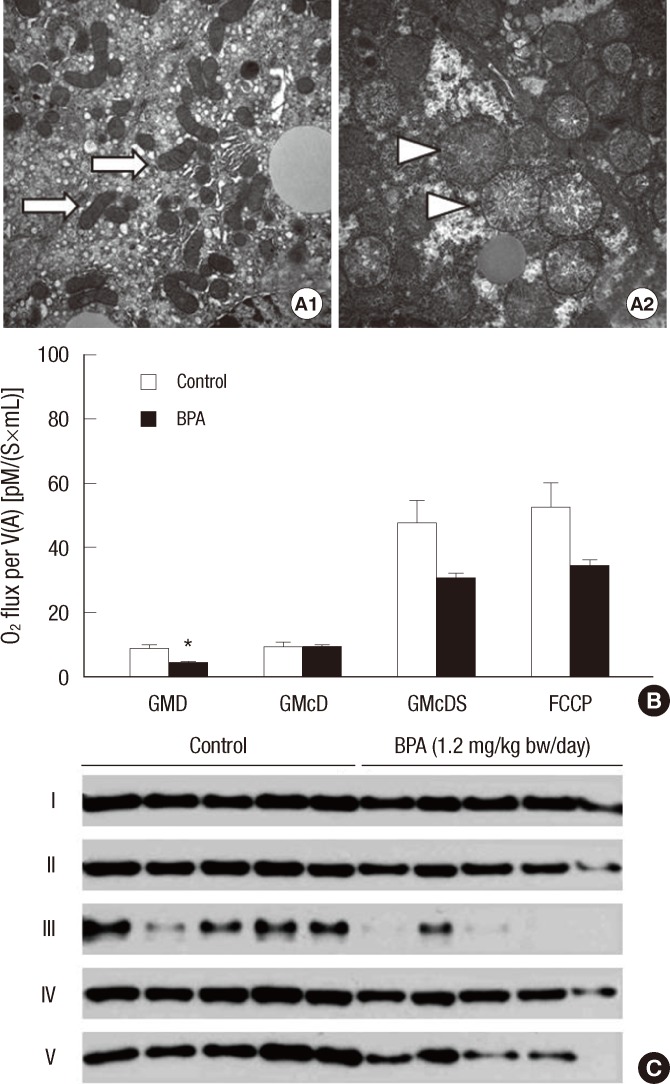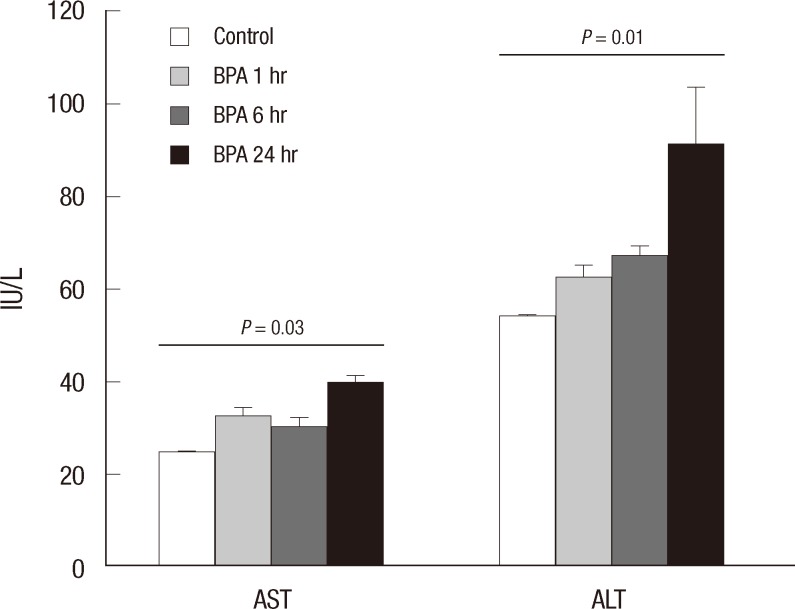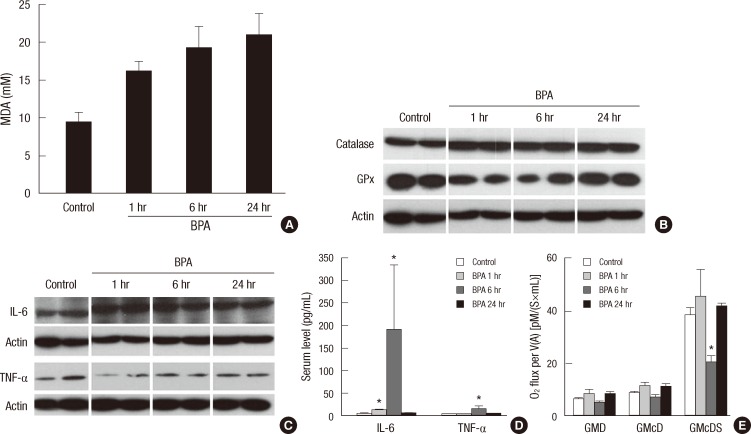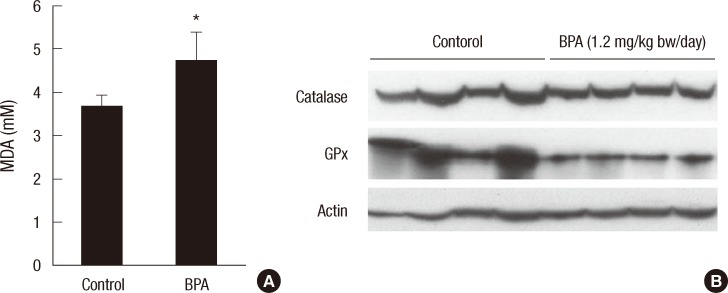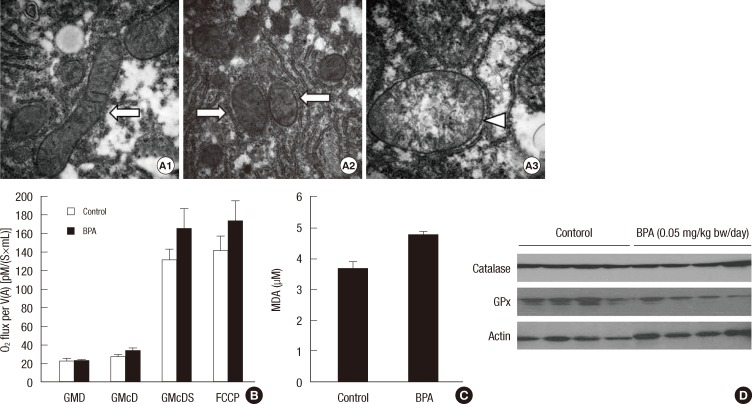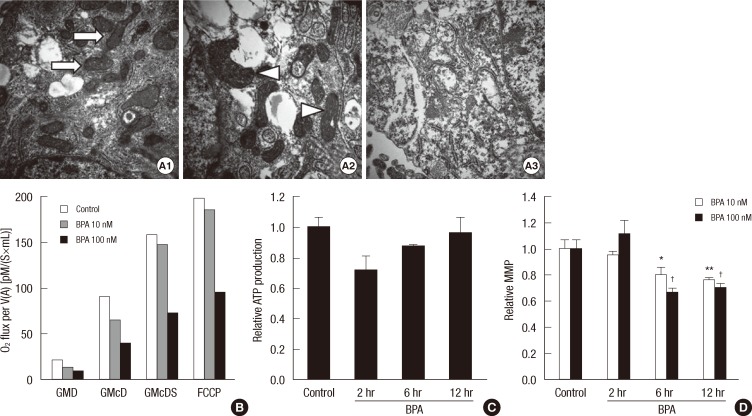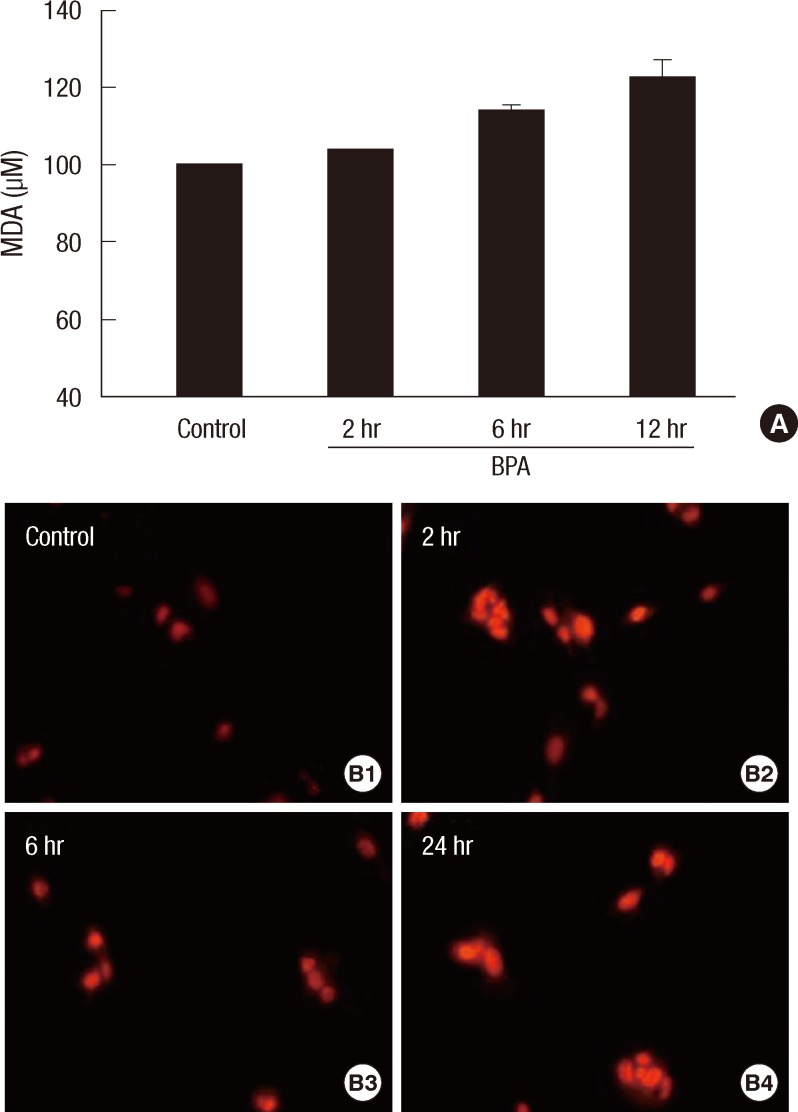Abstract
Bisphenol A (BPA) has been reported to possess hepatic toxicity. We investigated the hypothesis that BPA, below the no observed adverse effect level (NOAEL), can induce hepatic damage and mitochondrial dysfunction by increasing oxidative stress in the liver. Two doses of BPA, 0.05 and 1.2 mg/kg body weight/day, were administered intraperitoneally for 5 days to mice. Both treatments impaired the structure of the hepatic mitochondria, although oxygen consumption rate and expression of the respiratory complex decreased only at the higher dose. The hepatic levels of malondialdehyde (MDA), a naturally occurring product of lipid peroxidation, increased, while the expression of glutathione peroxidase 3 (GPx3) decreased, after BPA treatment. The expression levels of proinflammatory cytokines such as interleukin-6 (IL-6) and tumor necrosis factor-α (TNF-α) also increased. In HepG2 cells, 10 or 100 nM of BPA also decreased the oxygen consumption rate, ATP production, and the mitochondrial membrane potential. In conclusion, doses of BPA below the NOAEL induce mitochondrial dysfunction in the liver, and this is associated with an increase in oxidative stress and inflammation.
Keywords: Bisphenol A, Liver, Mitochondria, Oxidative Stress, Inflammation
INTRODUCTION
Bisphenol A (BPA), a key monomer in the production of polycarbonate plastics and epoxy resin, is widely used in a variety of products, including baby bottles, food storage containers, and dental sealants (1, 2). Trace amount of BPA released from these products leads to human exposure. Thus, in humans, BPA is detected not only in serum and urine but also in the placenta and amniotic fluid (3, 4).
The United States (US) Food and Drug Administration (FDA) has announced a no observed adverse effect level (NOAEL) of 5 mg BPA/kg body weight (bw)/day, and the European Food Safety Authority (EFSA) and the US Environmental Protection Agency (EPA) have derived a tolerable daily intake (TDI), or reference dose, of 0.05 mg/kg bw/day (5-7) based on rodent studies (8, 9). However, considering that human exposure is abundant and prolonged, there are controversies about this criteria based on single dose exposure in animal studies. Recently, several researches have been being carried and these suggest that a low dose of BPA below the NOAEL have significant effects (10-13).
The adverse effects of BPA are largely related to its estrogenic activity (14, 15), and result in disturbances to reproductive function (16), steroidogenesis (17), and adipogenesis (18). However, BPA has other effects such as inflammatory cytokine (18, 19) and an increase of oxidative stress (20-22), which is independent of estrogenic activity.
The liver is the major organ for the metabolism and detoxification of xenobiotics, including BPA (23). Therefore, the liver could be largely exposed to BPA, and could be susceptible to lower doses, than other organs. In humans, the urinary concentration of BPA was associated with abnormal liver function (24). There are some reports that high doses of BPA altered liver weights in mice or rats (8, 9) and decreased the viability of rat hepatocytes (20). However, it is still unknown whether a low dose of BPA, below the NOAEL or TDI, has adverse effects on the liver. Therefore, we investigated the effects of doses of BPA below the NOAEL on hepatic function, especially focusing on oxidative stress and mitochondrial function both in vivo and in vitro.
MATERIALS AND METHODS
Animals
Specific pathogen-free C57BL/6 male mice at 3 weeks of age were purchased from the Orient Co., Ltd. (Seongnam, Korea). The mice were acclimatized to the laboratory environment for 1 week prior to the experiments, and then, divided into 3 groups. Mice were injected intraperitoneally with normal saline, 0.05 mg/kg body weight (bw)/day of BPA (referred to as the lower dose), or 1.2 mg/kg bw/day of BPA (referred to as the higher dose) every 24 hr for 5 days. The number of mice was 5 for each group, and the experiment was repeated at least 3 times from 2009 to 2010. All mice were housed in conventional plastic cages with free access to water and chow diet at 23℃ ± 2℃, 60% ± 10% humidity, and a 12-hr light/12-hr dark photoperiod. At the end of the study, mice were fasted for 8 hr, anesthetized, and then, sacrificed.
To investigate the time-course of effect of BPA, another separate animal study was conducted. In this study, mice were injected intraperitoneally with 1.2 mg/kg bw/day of BPA, and sacrificed 1, 6, and 24 hr after injection. The number of mice was 5 for each group, and the experiment was repeated twice.
All procedures involving the use of laboratory animals were in accordance with the Guide for Standard Operation Procedures, and were performed after receiving approval of the institutional animal care and use committee (IACUC) in the Clinical Research Institute, Seoul National University Bundang Hospital (IACUC approval No. BA1103-079/021-01).
Cells
HepG2 cells were grown in Roswell Park Memorial Institute (RPMI)-1640 medium (Invitrogen, Carlsbad, CA, USA) containing 10% fetal bovine serum, 10 mM HEPES (pH 7.4), 10.2 mML-glutamine, 50 mM sodium pyruvate, 2.5 mM β-mercaptoethanol, 0.1 mg/mL streptomycin, and 100 U/mL penicillin. All cells were incubated at 37℃ in a humidified chamber supplemented with 5% CO2. Cells were treated with 10 nM and 100 nM of BPA for 2, 6, 12, or 24 hr.
Materials
BPA (purity > 99%) was purchased from Sigma (St. Louis, MO, USA). BPA was mixed with 30% ethanol and diluted with water to the appropriate concentrations for the experiments.
Liver enzyme and cytokine measurements
Serum aspartate aminotransferase (AST) and alanine transferase (ALT) were determined by Beckman Coulter AU480 automatic biochemistry analysis system (Brea, CA, USA) with reagent kits provided by the manufacturer. IL-6 and TNF-α were measured using a radioimmunoassay kit (Linco, St. Charles, MO, USA), following the protocol provided by the manufacturer
Transmission electron microscopy
Liver and pancreas tissues were dissected, cut into small sections (1 × 1 mm), and immersed in 2.5% glutaraldehyde at 4℃. Samples were post fixed in 1% osmium tetroxide in 0.1 M phosphate or cacodylate buffer at pH 7.2 for 1.5 hr. Samples were then washed with water, dehydrated in an increasing series (50%, 60%, 70%, 80%, 90%, and 100%) of ethanol, and immersed in propylene oxide (Acros Organics, Morris Plains, NJ, USA) and then EPON epoxy resin (Electron Microscopy Polysciences, Hatfield, PA, USA). Samples embedded in the epoxy resin were put into a capsule and polymerized at 38℃ for 12 hr and at 60℃ for 48 hr.
Samples were then cut into 50-µm thick ultrathin slices by using an ultramicrotome (RMC MT-XL), and stained with 4% uranyl acetate and 4% lead citrate. Structures were examined by transmission electron microscopy (15,000 × and 50,000 × magnification).
Mitochondrial function assays
High-resolution respirometry was used to measure the oxygen consumption rate of the mitochondria of both the liver tissues and HepG2 cells. The oxygen consumption rate of the mitochondria was measured as described previously (25). Briefly, the hepatic mitochondria were isolated by centrifugation in MIB buffer, containing 10 mM Tris-HCl pH 7.4, 250 mM sucrose, and 1 mM EDTA, and 200 µg of mitochondria was mixed with MIRO5 buffer, containing 0.5 mM EGTA, 3 mM MgCl2 · 6H2O, 60 mM K-lactobionate, 20 mM taurine, 10 mM KH2PO4, 20 mM HEPES, 110 mM sucrose, and 1 g/L BSA. The sample was transferred to the chamber of an Oxygraph-2K apparatus (Oroboros, Innsbruk, Austria). The basal oxygen consumption rate (state 2 respiration) was recorded after the addition of 20 mM glutamate and 8 mM malate as substrates of complex I, and then, state 3 respiration was assessed by the addition of 2 mM ADP (GMD). Cytochrome c (GMcD) was added to assess the integrity of the outer mitochondrial membrane. Subsequently, 10 mM succinate (GMcDS), as a substrate of complex II, and 0.5 M carbonylcyanide p-triflouromethoxyphenylhydrazone (FCCP), as an uncoupler, were added sequentially. The oxygen consumption rate was expressed as picomoles of oxygen consumed/s/mg of mitochondrial protein.
The cellular ATP production and mitochondrial membrane potential (MMP) were also measured in the HepG2 cells. Cellular ATP levels were measured using a luminescence ATP detection assay kit (PerkinElmer, Waltham, MA, USA). The assay was carried out in 96-well plates, according to the manufacturer's instruction. The luminescence was detected on a microplate reader (Wallac Victor3V 1420 Multilabel Counter; PerkinElmer) as counts per second (CPS). The relative ATP level was calculated by dividing the CPS of the BPA-treated samples by those of the control samples.
The MMP was determined by measuring the red fluorescence of the cationic carbocyanine dye JC-1 (5, 5', 6, 6'-tetrachloro-1, 1', 3, 3'-tetraethylbenzimidazolylcarbocyanine iodide) (Invitrogen). Briefly, 1 × 104 cells were loaded on the 96-well plate, 200 µL of 2 µM JC-1 was added to the media, and then the plate was incubated at 37℃ for 2 hr. Following the incubation, the media was removed from each well of the plate and washed with phosphate-buffered saline (PBS). The fluorescence was measured at an excitation wavelength of 485 nm and an emission wavelength of 590 nm with a fluorescent microplate reader (Wallac Victor3V 1420 Multilabel Counter; PerkinElmer). The MMP was expressed as the ratio of red fluorescence (590 nm) to green fluorescence (485 nm).
Protein analysis (western blot)
Liver tissue was harvested at the end of the study and subjected to immunoblotting analysis. Tissues were homogenized in lysis buffer (Cell Signaling Tech., Danvers, MA, USA), and the protein concentration was determined using a protein assay kit (Pierce Biotechnology, Rockford, IL, USA).
Protein (12 µg) was mixed with gel loading buffer, containing 62.5 mM Tris-HCl, 2% sodium dodecyl sulfate (SDS), 5% 2-mercaptoethanol, 13% glycerol, and 0.013% bromophenol blue, and loaded onto a 9% SDS-polyacrylamide electrophoresis gel, which was electrophoresed in buffer containing 25 mM Tris-HCl, 250 mM glycine, and 0.1% SDS. The protein was transferred to a polyvinylidene difluoride membrane in buffer containing 25 mM Tris, 192 mM glycerin, and 20% methanol (pH 8.3) for 1 hr, and the membrane was then washed with TBS buffer. Primary antibody was diluted with TBS buffer with 5% skim milk and incubated with the membrane overnight at 4℃. The primary antibodies used were complex I (20 kDa, MitoSciences company, Eugene, OR, USA), complex II (32 kDa), complex III (45 kDa), complex IV (25 kDa), complex V (55 kDa), interleukin-6 (IL-6) (24 kDa, AbCam, Cambridge, MA, USA), tumor necrosis factor-α (TNF-α) (17 kDa, Santa Cruz Biotechnology, Inc., Santa Cruz, CA, USA), catalase (55 kDa, Santa Cruz), glutathione peroxidase 3 (GPx3) (2 kDa, Santa Cruz), and actin (42 kDa, Sigma). After washing with TBS buffer, the membrane was re-incubated with secondary antibody for 1 hr at room temperature. The secondary antibodies were anti-rabbit, anti-goat, and anti-mouse antibodies.
Oxidative stress assays
The thiobarbituric acid reactive substance (TBARS) assay was used to measure the oxidative stress in the hepatic tissues or HepG2 cells. Tissues or cells were homogenized in 250 µL of RIPA buffer (50 mM Tris-HCl, pH 8.0, with 150 mM sodium chloride, 1.0% Igepal CA-640 [NP-40], 0.5% sodium deoxycholate, and 0.1% sodium dodecyl sulfate) on ice. Samples were centrifuged, and the supernatant was stored at -80℃ until use. Homogenates were assayed in duplicate using a TBARS assay kit (Cayman Chemical, Ann Arbor, MI, USA) to determine the content of malondialdehyde (MDA). Samples were mixed with SDS solution and color reagent, boiled for 1 hr, incubated on ice for 10 min, and centrifuged at 1,600 g at 4℃ for 10 min. Samples were loaded with MDA standards on a 96-well plate, and the absorbance at 530-540 nm was read. The TBARS levels were calculated from a standard curve of MDA.
In HepG2 cells, the intracellular reactive oxygen species (ROS) was also measured using the ROS-sensitive fluorescent indicator dihydroethidium (DHE) (Sigma). The cells were incubated with 10 mg/L DHE for 30 min at 37℃, and then washed twice with PBS. Following this, the cells were treated with BPA (100 nM), and then, fluorescent microscopy images were obtained.
Statistical analysis
Statistical analysis was performed by non-parametric analysis by using the Mann-Whitney and Kruskal-Wallis tests. Statistical significance was assumed at P < 0.05.
RESULTS
Impairment of mitochondrial structure and function by BPA
There were no differences in the weight of the liver or its histology (studied by hematoxylin and eosin staining) between the control and BPA-treated mice (data not shown). However, the hepatic mitochondria in the mice treated with 1.2 mg/kg bw/day of BPA were much more swollen than those in the control mice, as viewed with transmission electron microscopy (Fig. 1A). The oxygen consumption rates (glutamate + malate + ADP [GMD], GMcD + succinate [GMcDS], and carbonylcyanide p-triflouromethoxyphenylhydrazone [FCCP]) were reduced in the hepatic mitochondria in the BPA-treated mice (Fig. 1B), especially state 3 respiration (GMD), which significantly decreased (P = 0.03). The expression of the respiratory complex III and V was also reduced in the BPA-treated mice compared to the control mice (Fig. 1C).
Fig. 1.
Structure and function of hepatic mitochondria in the mice treated with 1.2 mg/kg bw/day of BPA for 5 days. (A) Morphology of hepatic mitochondria by transmission electron microscopy (150,000 × magnification). Control mice (A1) and BPA-treated mice (A2). Normal mitochondria (arrows) and swollen mitochondria (arrowheads). (B) Oxygen consumption rate of hepatic mitochondria. GMD, glutamate + malate + ADP; GMcD, GMD + cytochrome c; GMcDS, GMcD + succinate; FCCP, uncoupler (*P < 0.05 compared to control). (C) The respiratory complex I-V of hepatic mitochondria.
Acute changes of liver enzymes by BPA
To investigate the possible hepatic toxicity of BPA, we measured the liver serum enzymes AST and ALT. Within 24 hr of a single injection of 1.2 mg/kg bw/day of BPA, both AST and ALT levels significantly increased (P = 0.03 and 0.01, respectively) (Fig. 2). However, we could not find any difference after 5 days of treatment (ALT, 60 ± 14 IU/L vs 57 ± 10 IU/L, P > 0.05), although serum AST levels showed an increasing tendency in BPA-treated mice (30 ± 4 U/L vs 46 ± 20 U/L, P > 0.05).
Fig. 2.
Serum AST and ALT levels after a single injection of 1.2 mg/kg bw/day of BPA.
Oxidative stress and inflammatory cytokines in the liver
We next investigated the mechanism of mitochondrial dysfunction in the liver. Since both oxidative stress and inflammation can induce hepatic mitochondrial dysfunction (26), we measured the hepatic MDA concentrations and the hepatic expression of IL-6 and TNF-α at 1, 6, and 24 hr after the injection of 1.2 mg/kg bw/day of BPA.
The hepatic concentration of MDA, which is a product of lipid peroxidation, was measured as an indicator of oxidative stress. After a single injection of BPA, MDA concentrations gradually increased over time for 6 hr (P = 0.04) (Fig. 3A), while the hepatic expression of GPx3, an important antioxidant enzyme, decreased over the same period (Fig. 3B). In contrast, the expression of catalase remained unchanged. Because inflammatory cytokines can induce oxidative stress, we measured the hepatic expression of IL-6 and TNF-α. IL-6 expression increased 1 and 6 hr after BPA injection, suggesting a pathogenic role, while the expression of TNF-α was unchanged (Fig. 3C). Serum IL-6 and TNF-α levels showed similar results (P < 0.01, P = 0.02 respectively) (Fig. 3D).
Fig. 3.
Changes in the levels of oxidative stress and inflammatory cytokines at 1, 6, and 24 hr after a single injection of BPA (1.2 mg/kg bw/day). (A) MDA concentrations in the liver. (B) Catalase and GPx3 in the liver. (C) IL-6 and TNF-α levels in the liver. (D) Serum IL-6 and TNF-α levels. (E) Oxygen consumption rate in hepatic mitochondria. GMD, glutamate + malate + ADP; GMcD, GMD + cytochrome c; GMcDS, GMcD + succinate (*P < 0.05 compared to control).
Mitochondrial function measured as the oxygen consumption rate significantly decreased 6 hr after BPA treatment (P = 0.03), but had recovered by 24 hr (Fig. 3E). Therefore, this showed that the changes in the levels of inflammatory cytokines and oxidative stress over time had a temporal association with hepatic mitochondrial dysfunction, and we hypothesized that BPA induced expression of proinflammatory cytokines, including in the liver, which might increase hepatic oxidative stress. Under BPA-treated conditions, hepatic antioxidant enzyme levels decreased; thus, hepatocytes could not be protected from BPA-induced oxidative stress resulting in mitochondrial dysfunction. To verify this hypothesis in the mice treated for 5 days, we measured MDA and found that MDA concentrations were elevated (Fig. 4A). Furthermore, the expression level of GPx3 decreased in the BPA-treated liver (Fig. 4B).
Fig. 4.
Oxidative stress in the liver of mice treated with BPA (1.2 mg/kg bw/day) for 5 days. (A) MDA concentrations (*P < 0.05 compared to control). (B) Catalase and GPx3 in the liver.
Effect of lower dose of 0.05 mg/kg bw/day BPA on hepatic oxidative stress
We demonstrated that 1.2 mg/kg bw/day of BPA, which is lower than the NOAEL in mice (5 mg/kg bw/day), increased hepatic oxidative stress, and impaired mitochondrial function. Therefore, we treated mice with a lower dose of 0.05 mg/kg bw/day BPA. The electron microscopy findings were not consistent, and the morphology of the hepatic mitochondria varied between individual mice; the mitochondrial morphology appeared normal in some mice, but very large and swollen mitochondria were frequently observed in others (Fig. 5A). These results suggested that susceptibility to BPA could differ on an individual basis. The oxygen consumption rate of hepatic mitochondria showed no difference between 0.05 mg/kg bw/day BPA-treated mice and controls, but variations were observed between the individuals (Fig. 5B). MDA concentrations representing oxidative stress also increased compared to the controls, even in the mice treated with the lower dose of BPA, although this apparent difference was not statistically significant (Fig. 5C). GPx3 expression level also decreased in the mice treated with lower dose of BPA (Fig. 5D). Our results suggested that even the "tolerable" or "acceptable" lower dose of BPA could also induce hepatic oxidative stress and mitochondrial dysfunction, depending on individual susceptibility.
Fig. 5.
Structure and function of hepatic mitochondria in the mice treated with BPA (0.05 mg/kg bw/day) for 5 days. (A) Morphology of hepatic mitochondria by transmission electron microscopy (500,000 × magnification). Control (A1) and BPA-treated mice (A2, A3). Normal mitochondria (arrows) and swollen and cristae-disrupted mitochondria (arrowhead). (B) Oxygen consumption rate of hepatic mitochondria. GMD, glutamate + malate + ADP; GMcD, GMD + cytochrome c; GMcDS, GMcD + succinate; FCCP, uncoupler. (C) MDA concentrations in the liver. (D) Catalase and GPx3 in the liver.
Effect of BPA on mitochondrial function in HepG2 cells
To confirm the effects of BPA on hepatic mitochondria in vitro, HepG2 cells were treated with 2 different concentrations of BPA (10 nM and 100 nM). Treatment of HepG2 cells with BPA for 2 hr lead to a deteriorated mitochondrial architecture (Fig. 6A), and this was more severe in the 100 nM-treated mice than the 10 nM-treated HepG2 cell. Not only the morphology but also the function of the mitochondria was impaired by BPA treatment; oxygen consumption rates were reduced according to the dose (Fig. 6B). These results were replicable between 3 separate experiments. We also measured other parameters of mitochondrial function and observed the same results; ATP consumption (Fig. 6C) and MMP (Fig. 6D) were reduced after BPA treatment. To exclude the possibility that cell death caused the mitochondrial dysfunction, a cell viability assay using 3-(4,5-dimethylthiazol-2-yl)-2,5-diphenyltetrazolium bromide (MTT) was performed, and no cell death was observed (data not shown). To confirm the increase of oxidative stress by BPA in hepatocytes, we measured the MDA concentrations (Fig. 7A) and DHE activities (Fig. 7B), and BPA increased both of them.
Fig. 6.
Structure and function of the mitochondria in HepG2 cells treated with BPA. (A) Mitochondrial morphology of HepG2 cells by transmission electron microscopy (300,000 × magnification). Control HepG2 cells (A1), 10 nM BPA-treated HepG2 cells (A2), and 100 nM BPA-treated HepG2 cells (A3). Normal mitochondria (arrows) and swollen and cristae-disrupted mitochondria (arrowheads). (B) Oxygen consumption rate of HepG2 cells. GMD, glutamate + malate + ADP; GMcD, GMD + cytochrome c; GMcDS, GMcD + succinate; FCCP, uncoupler. (C) ATP production after the treatment with 100 nM BPA. (D) MMP after the treatment with 10 or 100 nM BPA (*P < 0.05 compared to control; †P < 0.01 compared to control).
Fig. 7.
Oxidative stress in HepG2 cells treated with 100 nM BPA. (A) MDA concentrations determined by a TBARS assay kit. (B) Fluorescence after the ROS-sensitive indicator DHE staining. Control (B1), 2 hr (B2), 6 hr (B3), and 24 hr (B4) after the treatment of 100 nM BPA.
DISCUSSION
The present study demonstrated that a low dose of BPA, below the NOAEL or TDI (the so-called "tolerable" or "acceptable" dose), induces mitochondrial dysfunction and structural changes in the mouse liver. BPA increased hepatic oxidative stress and proinflammatory cytokines, and decreased antioxidant enzyme expression both in vivo and in vitro. All these findings suggest that a low dose of BPA can also induce hepatic dysfunction.
The strength of this study is to demonstrate that BPA below the permissible limit induces mitochondrial dysfunction and structural changes in the liver in vivo. Only in vitro data have been reported that BPA inhibits mitochondrial function (20).
Recently, the oxidative stress was proposed as another adverse cellular effect of BPA in the liver (21). BPA increased the generation of ROS and induced cellular apoptosis in hepatocytes (22). Oxidative stress can induce mitochondrial damage, and damaged mitochondria can generate more ROS. Mitochondria are vulnerable to ROS due to impairment of the antioxidant and DNA repair enzyme systems (27). Accumulation of oxidative damage in the mitochondria induces mitochondrial dysfunction, mitochondrial DNA depletion, and cell apoptosis (26). In this study, BPA increased ROS production, as assessed by the measurement of MDA concentration. An increase in ROS was observed even 1 hr after BPA administration. Although mitochondrial dysfunction was not observed, a very low dose of BPA, i.e., 0.05 mg/kg bw/day, also increased ROS and decreased antioxidant enzymes. Although further studies are required to clarify the cause and effect relationship, it is suggested that oxidative stress might be the possible mechanism of this BPA-induced mitochondrial dysfunction.
In this study, an increase in the levels of IL-6 and TNF-α was observed following BPA treatment. Although ROS can increase proinflammatory cytokines (28), proinflammatory cytokines themselves can induce oxidative stress (29). We showed that the expression of IL-6 increased 1 and 6 hr after BPA injection, and serum MDA concentrations gradually increased over time for 24 hr. These results suggested that IL-6 might play a pathogenic role in BPA-induced ROS generation and mitochondrial dysfunction.
The cell has various defense mechanisms against oxidative stress, including scavenging enzyme systems such as catalase and GPx3. In this study, BPA reduced GPx3 expression consistent with the previous studies that reported the reduction of catalase and GPx activities in the liver and kidney of male ICR mice (30) and the sperm of Wistar rats (31). It has been suggested that BPA exposure produces ROS by inhibiting antioxidant enzymes, or that antioxidant enzymes are depleted because of ROS production.
In this study, a single BPA injection acutely increased liver enzymes, although the levels of liver enzymes upon treatment had a tendency to be similar to those of the control after the successive BPA injections for 5 days. We can postulate that BPA may induce hepatocyte damage, but there are abundant mechanisms to compensate for this. Therefore, the hepatotoxic effects of BPA could be counteracted, and this may be the reason why the previously elevated hepatic enzyme levels were again reduced after 5 days of treatment in our study, although we did not examine the possible compensatory mechanism.
In this study, we injected BPA intraperitoneally, while human is usually exposed to BPA via the oral route. This may represent a limitation of this study, because the route of administration can change the BPA bioavailability and metabolism (32). However, even after considering pharmacokinetics of BPA, doses of BPA, which we injected intraperitoneally in this experiment, may be equated to about 0.15 mg/kg/day and 4 mg/kg/day for the oral administration and these are below the NOAEL.
In conclusion, a low dose of BPA induces mitochondrial dysfunction in the liver, and this is associated with an increase in oxidative stress and inflammation.
Footnotes
This study was supported by a grant of the Korea Healthcare Technology R&D Project, Ministry of Health & Welfare, Korea (Grant No.: A090152).
References
- 1.Brotons JA, Olea-Serrano MF, Villalobos M, Pedraza V, Olea N. Xenoestrogens released from lacquer coatings in food cans. Environ Health Perspect. 1995;103:608–612. doi: 10.1289/ehp.95103608. [DOI] [PMC free article] [PubMed] [Google Scholar]
- 2.Olea N, Pulgar R, Pérez P, Olea-Serrano F, Rivas A, Novillo-Fertrell A, Pedraza V, Soto AM, Sonnenschein C. Estrogenicity of resin-based composites and sealants used in dentistry. Environ Health Perspect. 1996;104:298–305. doi: 10.1289/ehp.96104298. [DOI] [PMC free article] [PubMed] [Google Scholar]
- 3.Ikezuki Y, Tsutsumi O, Takai Y, Kamei Y, Taketani Y. Determination of bisphenol A concentrations in human biological fluids reveals significant early prenatal exposure. Hum Reprod. 2002;17:2839–2841. doi: 10.1093/humrep/17.11.2839. [DOI] [PubMed] [Google Scholar]
- 4.Calafat AM, Kuklenyik Z, Reidy JA, Caudill SP, Ekong J, Needham LL. Urinary concentrations of bisphenol A and 4-nonylphenol in a human reference population. Environ Health Perspect. 2005;113:391–395. doi: 10.1289/ehp.7534. [DOI] [PMC free article] [PubMed] [Google Scholar]
- 5.Bisphenol A action plan summary. USEPA. [accessed on 1 March 2012]. Available at http://www.epa.gov/oppt/existingchemicals/pubs/actionplans/bpa.html.
- 6.Draft assessment of bisphenol A for use in food contact appliations. USFDA. [accessed on 1 March 2012]. Available at http://www.fda.gov/ForConsumers/ConsumerUpdates/UCM169136.
- 7.European Food Safety Authority (EFSA) Statement of EFSA on a study associating bisphenol A with medical disorders. EFSA J. 2008;838:1–3. [Google Scholar]
- 8.Tyl RW, Myers CB, Marr MC, Thomas BF, Keimowitz AR, Brine DR, Veselica MM, Fail PA, Chang TY, Seely JC, et al. Three-generation reproductive toxicity study of dietary bisphenol A in CD Sprague-Dawley rats. Toxicol Sci. 2002;68:121–146. doi: 10.1093/toxsci/68.1.121. [DOI] [PubMed] [Google Scholar]
- 9.Tyl RW, Myers CB, Marr MC, Sloan CS, Castillo NP, Veselica MM, Seely JC, Dimond SS, Van Miller JP, Shiotsuka RN, et al. Two-generation reproductive toxicity study of dietary bisphenol A in CD-1 (Swiss) mice. Toxicol Sci. 2008;104:362–384. doi: 10.1093/toxsci/kfn084. [DOI] [PubMed] [Google Scholar]
- 10.vom Saal FS, Hughes C. An extensive new literature concerning low-dose effects of bisphenol A shows the need for a new risk assessment. Environ Health Perspect. 2005;113:926–933. doi: 10.1289/ehp.7713. [DOI] [PMC free article] [PubMed] [Google Scholar]
- 11.Welshons WV, Nagel SC, vom Saal FS. Large effects from small exposures. III Endocrine mechanisms mediating effects of bisphenol A at levels of human exposure. Endocrinology. 2006;147:S56–S69. doi: 10.1210/en.2005-1159. [DOI] [PubMed] [Google Scholar]
- 12.Dairkee SH, Seok J, Champion S, Sayeed A, Mindrinos M, Xiao W, Davis RW, Goodson WH. Bisphenol A induces a profile of tumor aggressiveness in high-risk cells from breast cancer patients. Cancer Res. 2008;68:2076–2080. doi: 10.1158/0008-5472.CAN-07-6526. [DOI] [PubMed] [Google Scholar]
- 13.Wetherill YB, Hess-Wilson JK, Comstock CE, Shah SA, Buncher CR, Sallans L, Limbach PA, Schwemberger S, Babcock GF, Knudsen KE. Bisphenol A facilitates bypass of androgen ablation therapy in prostate cancer. Mol Cancer Ther. 2006;5:3181–3190. doi: 10.1158/1535-7163.MCT-06-0272. [DOI] [PubMed] [Google Scholar]
- 14.Hiroi H, Tsutsumi O, Momoeda M, Takai Y, Osuga Y, Taketani Y. Differential interactions of bisphenol A and 17beta-estradiol with estrogen receptor alpha (ERalpha) and ERbeta. Endocr J. 1999;46:773–778. doi: 10.1507/endocrj.46.773. [DOI] [PubMed] [Google Scholar]
- 15.Kurosawa T, Hiroi H, Tsutsumi O, Ishikawa T, Osuga Y, Fujiwara T, Inoue S, Muramatsu M, Momoeda M, Taketani Y. The activity of bisphenol A depends on both the estrogen receptor subtype and the cell type. Endocr J. 2002;49:465–471. doi: 10.1507/endocrj.49.465. [DOI] [PubMed] [Google Scholar]
- 16.Takeuchi T, Tsutsumi O, Ikezuki Y, Takai Y, Taketani Y. Positive relationship between androgen and the endocrine disruptor, bisphenol A, in normal women and women with ovarian dysfunction. Endocr J. 2004;51:165–169. doi: 10.1507/endocrj.51.165. [DOI] [PubMed] [Google Scholar]
- 17.Zhang X, Chang H, Wiseman S, He Y, Higley E, Jones P, Wong CK, Al-Khedhairy A, Giesy JP, Hecker M. Bisphenol A disrupts steroidogenesis in human H295R cells. Toxicol Sci. 2011;121:320–327. doi: 10.1093/toxsci/kfr061. [DOI] [PubMed] [Google Scholar]
- 18.Ben-Jonathan N, Hugo ER, Brandebourg TD. Effects of bisphenol A on adipokine release from human adipose tissue: implications for the metabolic syndrome. Mol Cell Endocrinol. 2009;304:49–54. doi: 10.1016/j.mce.2009.02.022. [DOI] [PMC free article] [PubMed] [Google Scholar]
- 19.Wetherill YB, Akingbemi BT, Kanno J, McLachlan JA, Nadal A, Sonnenschein C, Watson CS, Zoeller RT, Belcher SM. In vitro molecular mechanisms of bisphenol A action. Reprod Toxicol. 2007;24:178–198. doi: 10.1016/j.reprotox.2007.05.010. [DOI] [PubMed] [Google Scholar]
- 20.Nakagawa Y, Tayama S. Metabolism and cytotoxicity of bisphenol A and other bisphenols in isolated rat hepatocytes. Arch Toxicol. 2000;74:99–105. doi: 10.1007/s002040050659. [DOI] [PubMed] [Google Scholar]
- 21.Bindhumol V, Chitra KC, Mathur PP. Bisphenol A induces reactive oxygen species generation in the liver of male rats. Toxicology. 2003;188:117–124. doi: 10.1016/s0300-483x(03)00056-8. [DOI] [PubMed] [Google Scholar]
- 22.Asahi J, Kamo H, Baba R, Doi Y, Yamashita A, Murakami D, Hanada A, Hirano T. Bisphenol A induces endoplasmic reticulum stress-associated apoptosis in mouse non-parenchymal hepatocytes. Life Sci. 2010;87:431–438. doi: 10.1016/j.lfs.2010.08.007. [DOI] [PubMed] [Google Scholar]
- 23.Knaak JB, Sullivan LJ. Metabolism of bisphenol A in the rat. Toxicol Appl Pharmacol. 1966;8:175–184. doi: 10.1016/s0041-008x(66)80001-7. [DOI] [PubMed] [Google Scholar]
- 24.Lang IA, Galloway TS, Scarlett A, Henley WE, Depledge M, Wallace RB, Melzer D. Association of urinary bisphenol A concentration with medical disorders and laboratory abnormalities in adults. JAMA. 2008;300:1303–1310. doi: 10.1001/jama.300.11.1303. [DOI] [PubMed] [Google Scholar]
- 25.Yoon YS, Byun HO, Cho H, Kim BK, Yoon G. Complex II defect via down-regulation of iron-sulfur subunit induces mitochondrial dysfunction and cell cycle delay in iron chelation-induced senescence-associated growth arrest. J Biol Chem. 2003;278:51577–51586. doi: 10.1074/jbc.M308489200. [DOI] [PubMed] [Google Scholar]
- 26.Ott M, Gogvadze V, Orrenius S, Zhivotovsky B. Mitochondria, oxidative stress and cell death. Apoptosis. 2007;12:913–922. doi: 10.1007/s10495-007-0756-2. [DOI] [PubMed] [Google Scholar]
- 27.Turrens JF. Superoxide production by the mitochondrial respiratory chain. Biosci Rep. 1997;17:3–8. doi: 10.1023/a:1027374931887. [DOI] [PubMed] [Google Scholar]
- 28.Dong W, Simeonova PP, Gallucci R, Matheson J, Flood L, Wang S, Hubbs A, Luster MI. Toxic metals stimulate inflammatory cytokines in hepatocytes through oxidative stress mechanisms. Toxicol Appl Pharmacol. 1998;151:359–366. doi: 10.1006/taap.1998.8481. [DOI] [PubMed] [Google Scholar]
- 29.Babbar N, Casero RA., Jr Tumor necrosis factor-alpha increases reactive oxygen species by inducing spermine oxidase in human lung epithelial cells: a potential mechanism for inflammation-induced carcinogenesis. Cancer Res. 2006;66:11125–11130. doi: 10.1158/0008-5472.CAN-06-3174. [DOI] [PubMed] [Google Scholar]
- 30.Kabuto H, Hasuike S, Minagawa N, Shishibori T. Effects of bisphenol A on the metabolisms of active oxygen species in mouse tissues. Environ Res. 2003;93:31–35. doi: 10.1016/s0013-9351(03)00062-8. [DOI] [PubMed] [Google Scholar]
- 31.Chitra KC, Latchoumycandane C, Mathur PP. Induction of oxidative stress by bisphenol A in the epididymal sperm of rats. Toxicology. 2003;185:119–127. doi: 10.1016/s0300-483x(02)00597-8. [DOI] [PubMed] [Google Scholar]
- 32.Pottenger LH, Domoradzki JY, Markham DA, Hansen SC, Cagen SZ, Waechter JM., Jr The relative bioavailability and metabolism of bisphenol A in rats is dependent upon the route of administration. Toxicol Sci. 2000;54:3–18. doi: 10.1093/toxsci/54.1.3. [DOI] [PubMed] [Google Scholar]



